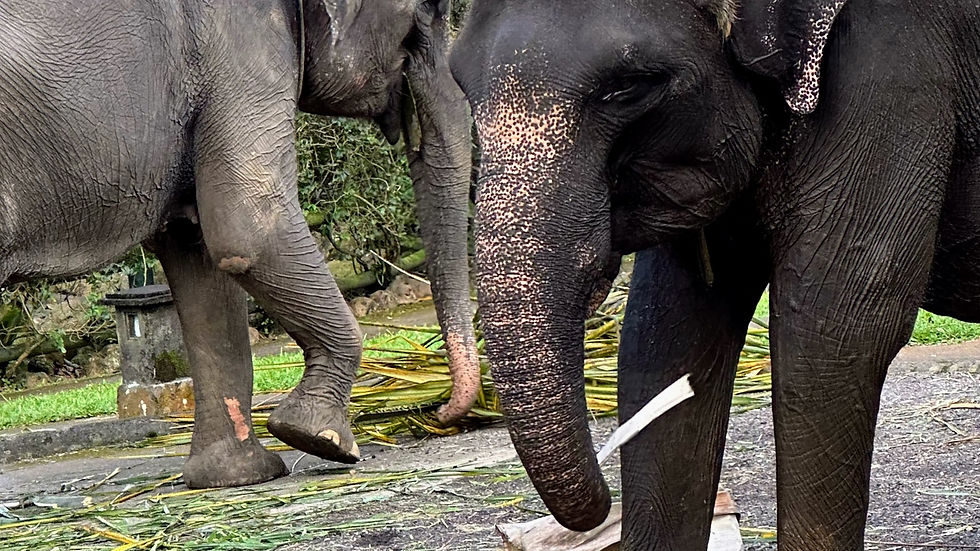Sacred, Not Spectacle: Understanding Bali’s Relationship with Animals
- Toni Reid
- Aug 9
- 4 min read

Please stop riding elephants; that is animal abuse.
Someone dropped that comment on my Bali travel video. One sentence. Zero punctuation. Maximum judgment.
Here’s the thing: I’ve seen the headlines. I’ve watched the documentaries. And if you’d asked me five years ago, I’d have probably agreed without blinking.
But then I went to Bali. I met the people. I met the elephants. I asked questions. And what I found? It wasn’t a photo-op dressed up as a wildlife encounter. It was a tradition. A relationship. A story that deserves more than a soundbite.
This post isn’t a defense. It’s an invitation — to understand before you judge, to travel like you mean it, and to realize that in Bali, not everything is what it Instagram-seems.

🐘 The Elephant in the Room (Literally)
When you picture elephant rides, what comes to mind?
Probably: chains, whips, exhausted animals, and a line of tourists holding GoPros and good intentions. That stereotype exists for a reason — in some places, it's heartbreakingly true.
But in Bali, the picture is more complicated.
Most elephants on the island aren’t native. They’re Sumatran elephants — a critically endangered subspecies — brought here decades ago, often rescued from illegal logging camps or relocated from shrinking habitats.
And here’s where things get interesting: certain Balinese sanctuaries (emphasis on certain) have taken that responsibility seriously. Like, “daily health checks, custom diets, four-vet rotations,” seriously.
One mahout (elephant caretaker) told me, “She eats better than I do.” After watching Sinta, a 3,000kg queen, devour a buffet of sugarcane, bananas, and herbal tonics, I believed him.

💡 What I Saw vs. What I Expected
I came in wary. Ready to cringe. Maybe even ready to walk out.
What I saw instead:
Mahouts who live with their elephants, often for decades.
Open, shaded enclosures with rivers and mud baths.
Elephants that weren’t paraded or prodded — they were greeted, spoken to like family.
Did some places still offer rides? Yes.
But here’s the nuance: the rides were short, slow, and optional. No heavy thrones strapped on their backs. No nonstop circuits. Just a single rider, a padded blanket, and a path through the forest.
And before you ask — no, I didn’t do it for the ‘Gram. I asked first. I listened. I watched. Then I made a choice I could stand behind.
✅ How to Do It Responsibly (Without Regret)
Look, I’m not here to tell you what’s right for you. But if you are curious, here’s how to do it ethically:
🏞️ 1. Vet the Vetting
Choose sanctuaries that are transparent about care, breeding (or lack thereof), and staff-to-elephant ratios. Ask what happens when elephants are retired. If they dodge, dip out.
💡 Pro tip: If the gift shop is bigger than the enclosure, walk away.
🐾 2. Ride Optional? Good Sign.
Ethical places won’t pressure you. Many don’t offer rides at all. And guess what? Watching an elephant bathe in a river is way more fun than riding one for five minutes while you try not to fall off.
🙋 3. Talk to the Mahouts
These are the people who really know the elephants — not the marketers. If they light up talking about their elephant’s personality, history, and health? You’re in the right place.

📍 Recommended Sanctuaries
A few places in Bali doing it better:
Mason Elephant Park & Lodge (Ubud) – controversial in the past, but now deeply focused on conservation, vet care, and education.
Bali Zoo Elephant Encounter (Sukawati) – more interaction-based than rides, with excellent transparency.
Bali Safari & Marine Park – home to elephants with ample space and conservation backing.
Always double-check before you go. Ethics evolve — and so should your choices.
🤔 So, Should You Ride an Elephant in Bali?
Maybe. Maybe not.
But the better question is: Do you understand what you’re participating in? Because that’s what matters.
For me, riding an elephant wasn’t a cheap thrill — it was a lesson in trust. In patience. In what it means to be a guest in someone else’s culture and someone else’s ecosystem.
Was it sacred? Not in the religious sense. But in the way quiet moments sometimes are, when you realize travel isn’t just about what you do — it’s about how you do it.

🛫 Final Takeaway: Travel Tip Meets Truth Bomb
Bali doesn’t need to be “tamed” for tourists. It needs to be understood.
So yes — ask questions. Get uncomfortable. Ditch the guidebook if you have to. But don’t cancel an entire culture because a headline told you to. The world’s too complicated — and too beautiful — for that kind of flat narrative.
Sometimes, the most responsible thing you can do… is listen.
Even if it’s to a 3-ton elephant who couldn’t care less about your camera.
Subscribe to my blog and join the culture crew for more insightful and helpful travel tips, and don't forget to check out my YouTube Bali playlist.





Comments